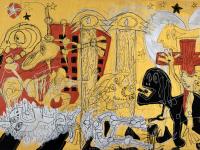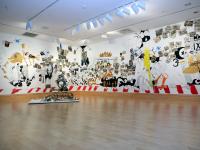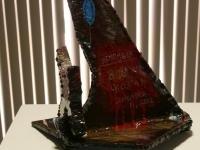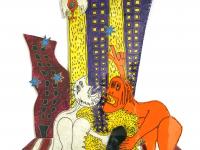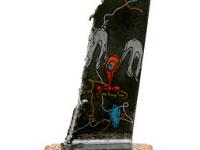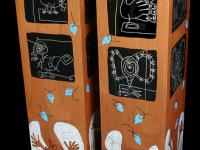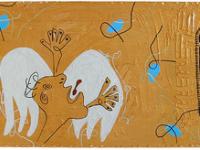
Artists Registry
jersey city NJ United States
Artist's Statement
There is a global village
where ancient grievances, endless
agonies turn on lathes
of uncountable echoes. There is
a plea never heard in the din of gain,
an infinite vowel careening
from a severed head suspended
between Guernica and Nankind
New York and Babi Yaar,
Wounded Knee and Santiago de Chile
tossed by the bull
of ancient grievances. We mourn
in the marrow of blue-violet ashes
where we would the bone dust
of fallen comrades turn to light
in the figure of an iris. Who
are the fallen? Is it Adam, his finger
still stuck to the finger of god
with primordial slime?
khadesha’s clavicle bent by the pestles
of rage in the crucible
of negotiations, vendetta and famine?
Whose memory survives this mausoleum
suspended beneath two pillars of smoke,
the archeological dust of Antioch,
a cave on Okinawa,
the 1000 - year stench of Kosovo?
If it is our will there shall be
more of these monuments.
Duda Penteado Revisits a Barrio of the Global Village
on the Tenth Anniversary of 11 September 2001
Duda Penteado has been well positioned to explain 911 from a Brazilian-American perspective. On September 11, 2001 Duda was living in Jersey City only a short distance from the World Trade Center. On any given sunny September day, the rays of the morning sun would cast its long shadows onto the waters of the Hudson River that separates New York City from Jersey City. His sister Cristina was living with her husband Mateus in the apartment buildings at the Battery Park City in the shade of the towers. As the sun moves through its daily course, in the afternoon one sees its afternoon shadows cast by the glass and steel residential towers of Battery Park City. And so Penteado saw before his eyes, the columns of smoke and ash rising on the day of the attack and then settling in the ensuing days of uncertainty.
As the towers burned Penteado was unable to make telephone contact with Cristina or Mateus. Finally, two days after the towers had collapsed, it was Duda’s mother who called from São Paulo to tell him that his sister and brother in law were safe.
The fact that a terrorist attack could succeed in New York City at the heart of world finance was a convincing reminder that the New York City is just another barrio in the global village under threat of terrorism.
Duda Penteado has personally marked each anniversary of the attack with an ongoing production of thematically related works of art. These works rely on visual devices and literary clues from the compositional plan and iconography of Pablo Picasso’s Guernica as a grid on which to build his own compositions. Guernica was chosen because it is so widely assumed that the village was the first populated area to fall victim to ‘strategic bombing’ in modern times.
But in fact, two decades earlier the French, Germans and their allies had already used ‘strategic bombing’ on the cities of their European enemies in the First World War: “The War to End All Wars.” The massive bombing of Nanking and other Chinese cities by the Japanese in WW II, and the subsequent ‘strategic bombing’ of London and Coventry were followed by retaliations in kind by the Anglo-American forces and their allies on Axis cities. All of this culminated in the fire-bombing of Tokyo in early 1945 and the ensuing immolation of Hiroshima and Nagasaki. The theoretical rationale for ‘strategic bombing’ is that it breaks the will of a populace to support its own government’s ability to wage war. We can respond with certainty with two answers to this theory. Terrorism, be it against an external enemy or internal rebellion has rarely succeeded and when it has, it is historically known that the success was temporary. In spite of the term terrorism having been born in historically recent times – during the French Revolution, terrorism is as old as human conflict. It is just that the means of spreading it have improved and escalated.
Penteado’s visual and literary clues evoke integration from fragmentation; death and resurrection; the emergence of beauty from the ashes. To accomplish these ends he has reinvented Picasso’s Guernica and extracted the doves of peace from the iconic flying severed head. A fragment of one of the steel girders from the towers has been resurfaced and repainted with life/death figures based on the severed head motif. They could be read alternately as ascending doves or falling leaves from the laurel crown of victory.
These horrible events and Duda Penteado’s call to resurrect beauty from the ashes remind me of a song sung by the striking North American coalminer’s during the late 1920’s and the 1930’s.
Which side are you on?
Which side are you on?
In Harlan County there are no neutrals
Which side are you on?
G.N.P
(George N. Preston, Ph.D. — Art Critic / Professor
Emeritus of Art History, City College, CUNY ) 2002
Resume
DUDA PENTEADO / SHORT BIO
www.dudapenteado.com
Born in São Paulo in 1968. Graduated in Communication by FIAM - SP, in the 1990s held some exhibitions in Brazil, then moved to New York. He continued his studies in the US, working initially in Muriel Studio in Soho , NY as an assistant to Sheila Marbain , a pioneer of the process of "silk monotype"in the U.S., who worked with the biggest names in the Pop Art movement. Since 1998 , Duda Penteado , lives and works between Brazil and the United States.
Penteado, completed several projects, lectures, exhibitions and murals in universities and institutions, such as:Jersey City Museum, em Jersey City, NJ; Biennale Internazionale Dell'Arte Contemporanea, em Firenze, 2009; Monique Goldstrom Gallery, NYC; MoAaA-The Museum of Art and Origins, NYC; BACI-The Brazilian American Cultural Institute, Washington DC; Museo de Las Americas, Denver, CO; CITYarts 272nd Mural, "Nature is Love on Earth", New York City Department of Parks & Recreation, The St. John's Recreation Center, Crown Heights, Brooklyn, NYC, 2008, 2009; Brooklyn College, Brooklyn, NY, New Jersey City University, Jersey City, NJ, Kean University, Union, NJ; Monmouth University, West Long Branch, NJ; Stevens Institute of Technology, Hoboken, NJ; Drew University Madison, NJ; Middlebury College, Vermont; UFES- Universidade Estadual do Espírito Santo, Vitoria, ES; UNESP-Universidade Estadual Paulista, SP, and SESC - SP.
He was President of the Artist Certification Board, Jersey City, NJ, until 2010. Received awards and recognition from various institutions in the United States, including : Urban Artist Fellowship Award no Vermont Studio Center, Johnson, VT; Goldman Sachs Student Art Project Grant, Jersey City, NJ (2006, 2007, 2008); Geraldine R. Dodge Foundation, The Robert Flaherty Film Seminar, Claremont, CA; Special Guest for Artistic Achievement & Commitment to YMCA Greater, NY-Youth, NYC; American Graphic Design Award, Interactive Multimedia Installation, NYC; Humanitarian Award from the Hudson County Chapter of the American Conference on Diversity, Jersey City, NJ; Kappa Pi International Honorary Art Fraternity - Eta Rho, New Jersey City University Chapter, NJ.


